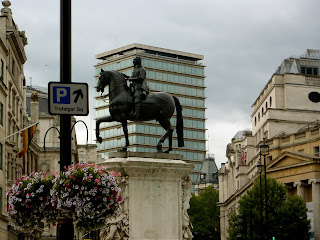Fountains Abbey was one of the most beautiful places I have ever been to. As we were entering the site, the sky was overcast and the scenery was dark. I found this lone tree and it attracted my attention. I thought it looked very bare and dry in a place there everything was so green and lush. With the contrast of the clouds in the background it seems almost eerie but with the definition of the full trees in the background, it sort of give the eye a break.
This next shot was also taken at Fountains Abbey. I composed it with the bushes in the foreground and a line of trees in the distance. I liked how the shrubs in front give the shot texture and depth. I also appreciated how each tree has a different shade to it giving it definition from the others around it. The bright green with hints of fall changes give it a beautiful overall color.

As I hiked up to a place called Anne Boleyn’s secret view I wasn’t sure what to expect. When I got there I was pleased. I found the abbey poking out through a mass of green grass and trees. A larger green tree was directly in my view and it gave my photo depth and showed distance. The old ruins of the abbey show in the background giving the pictures that element of a picturesque design. I also thought it was interesting how the stream leads the eye straight to the abbey. Perhaps highlighting the importance of the building. Or ensuring that he viewer realizes it is there, hidden in the emerald.

The view from our hostel in Windermere was a great sight. The uneven stonewalls lining the grassy pastures helped in the picturesque design. I also was drawn to the various textures. I could capture pastures, rolling hills, the lake and a lot of texture all in one shot. I also liked the way the fence in the front of the frame broke up the grass and gave it more depth.
When we took the ferry across the lake I had a gorgeous view. In this shot I wanted to capture the way the shadows cast upon the hills and trees. I also wanted to be able to show the reflections in the water. I thought it was interesting how in the distance you could notice the hills that faded in color the further away you were. This is exactly the concept we learned in our sketching lesson in class.

While in the Lake District, particularly at a town called Ambleside, I decided to experiment a little with my camera to see what sort of shot would look better. I took the same subject and area and angled my camera in two different directions. I got two very different shots. In one shot, I kept the tree close to the bottom of the frame. This makes the shot look short, and somewhat uninteresting as the cloudy sky fills half the frame. The other shot has the tree closer to the top of the frame. This gives the picture a more elongated look and much more interesting to look at.
This next shot was taken in Preston as we were taking our church history tour. We went to a lovely Japanese garden in a park. I came across this great green hill with a small brown bridge tucked right into the middle of it. I wanted to capture the bridge but not make it the center focus of the piece. I positioned the bridge so that it wasn’t in the center and used other browns from the trees and dirt to draw attention away from the varying color.

In another area of the same park we came across the River Ribble. I chose to capture this image because of its significance to the Mormon religion. The first concert baptisms in Britain took place in this river near to where the picture was taken. To me, this river, bridge and landforms mean so much. This is a beginning for the church. The gospel was carried out all over the world after these baptisms, much like the river carries things all over. The bridge also can show the connection between Mormonism in America and Britain at the time. I thought that the bridge just showing behind the trees was a nice view.
I enjoyed taking this next image because of the colors. In Northern England, the grass and trees are so green it almost looks fake. This picture only has a tiny enhancement dealing with the light and is otherwise true to color. I am so impressed with the different shades and hues in the shot. The brown of the shores and the blue water break up the mass of green to give the viewers eye a slight rest.

This last photo was taken at Chatsworth. Please ignore the slight glare in the corner; this was taken though a window. I would have thrown it out but I really appreciate this view. The old bridge give this shot a rugged yet elegant feeling, as it is an old bridge for a large manor. I also liked the trees spaced out through the shot. You can once again see how the fading of colors shows distance.













































